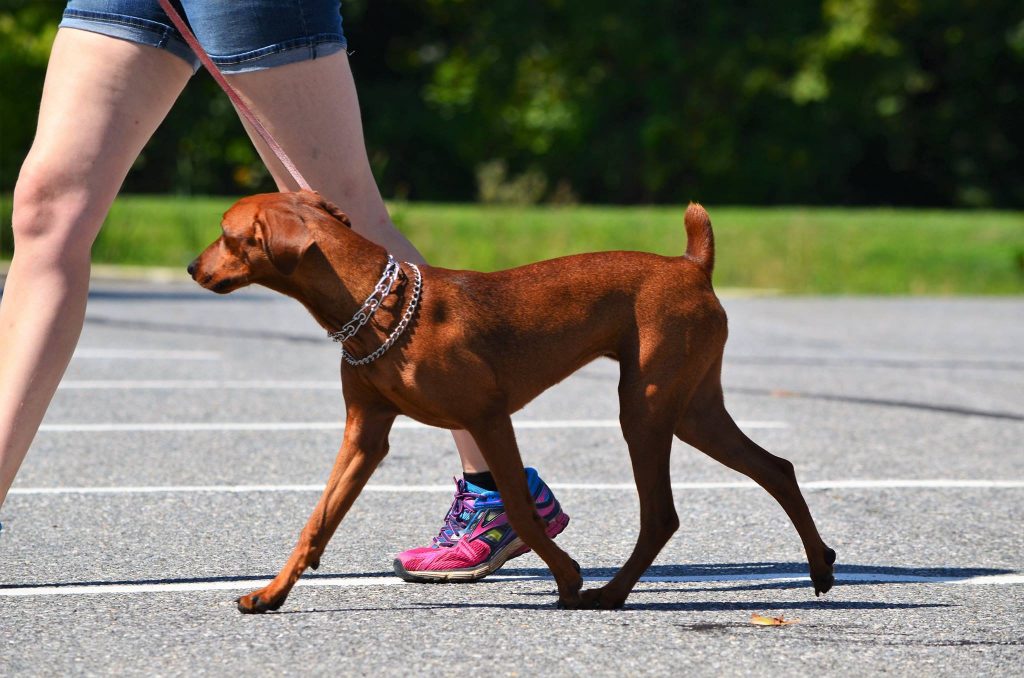While Ayla was a wee tot, I did food-based training and kept our obedience commands limited. This didn’t stop me from starting to teach her tricks, but I kept it to the basics. I patiently waited for her to hit the 18 week mark so I could enroll her in PUPS Dog Obedience, which is the obedience class I’ve mentioned in previous posts as the most effective obedience class I’ve ever taken in my life. It is not a socialization class. In fact, your dog is required to remain 15 feet away from all other dogs because PUPS specializes in reactive dogs. As I’ve owned reactive dogs in the past (Sophie and Pearl), I appreciate a class that makes it easier to handle those situations.
I’ve trained several dogs and taken a number of dog obedience classes and there is a big difference with PUPS. They teach behavioral training and they don’t use food. PUPS’ class aims to form a bond through obedience between dog and handler, such that your dog understands your word to be law and trusts you as a level-headed leader. PUPS’ class is a little different because it primarily uses verbal praise, which I think is a corner-stone to having a obedient, off-leash dog.

So I enrolled Ayla in PUPS. You would think having taken this class before with Pearl that I would know the answer to questions posed in class. Nope. I seemed to consistently answer things wrong. But I paid attention and I practiced. We were instructed – since Ayla was at the younger end of the spectrum of dogs in the class – to practice obedience training for at least 10 minutes twice a day. The advantage of being a single person with a dog is that you don’t have many other distractions, so Ayla and I applied the techniques on our morning and evening walks.

We practiced our stays while I threw pine cones past her on the sidewalk, toys past her in the house, did jumping-jacks and squats in close proximity to her, dropped splat into the grass, and sang childhood hand-clapping songs. We practiced heeling past dogs she knew, dogs she didn’t, humans she wanted to know, and bicycles. We heeled on sidewalks, on streets, in the grass, and around the outside parameter of a dog park. I was going for maximum distractions, but I gave lots of verbal praise for correct behavior. Obedience is not a time to be shy about talking to your dog, even if strangers are present and watching. It does pay off though. Ayla learned. I was pretty proud of her in class when we practiced sit stays and my little puppy sat calmly and watched curiously while a small dancing, singing penguin toy was released among the dogs to see if they’d break their stay. She sat and she didn’t break…because let’s face it when your human has already sang “Miss Mary Mack” while tossing pine cones past you, what’s a dancing penguin going to bring to the table?
We finished basic obedience class pretty solid on Sit, Stay, Stand, and Heel. Ayla was still lukewarm about Come and being a German Pinscher will no belly hair, she wasn’t fond of Down. She’d do down, but in a weird “my-elbows-don’t-have-to-touch” kind of way. But she still had a pretty solid foundation. Once you pass basic obedience, PUPS does recommend light-line training, which is a precursor to off-leash training. This involved getting myself a piece of 5 foot nylon cord and tying knots in it every foot. I then attached the cord to Ayla’s prong collar and continued to practice obedience as normal except for two changes, I did not hold the cord and Ayla was not on leash. The point of having Ayla drag the nylon cord was to condition her to the idea that she was off-leash, but that I still expected her to listen. The knots in the nylon cord gave me the ability to step on it if she decided to bolt or if I had to swoop down and use it as a leash, I had something to grasp. Each week as light-line training progressed, I cut off 1 foot (or 1 knot) of the cord until there was only a small handle of nylon cord left. By the end of light-line training, Ayla was heeling alongside of me behind the townhouses in the neighborhood by verbal cues alone.

A stick! 
Eww…water. 
Hold on stick, I’ll save you!
Once I had finished light-line training, I moved onto e-collar training. Ayla is an athletic and high-energy dog. I like walking and hiking, but I do not have nearly the same amount of energy that Ayla does…and I don’t really run often. This is why I decided to train a recall using an e-collar. This is my only use-case for the e-collar. Using the e-collar allows Ayla to do double-time during our walks. She bounds through the woods, jumping over trunks, streams, and brambles. She was once running through the woods with her friend Jade Dog while Jade’s human and I walked along the path. Jade has longer legs than Ayla, so she can often win in races, but Ayla has the gift of flight. Jade was chasing Ayla through the trees and then suddenly we heard a KAPLUNK! SPLASH! and see Jade paddling out of the middle of a stream that Ayla had apparently cleared in one 4 foot bound. E-collar training took us 2 weeks to learn and simply gave us a lot more freedom. It’s a choice and Ayla understands that. If I hold up her e-collar, she patiently lets me put it on because she knows she’ll get more chances to smell and run. Of her three collar options, she’d far prefer the e-collar to the gentle leader.

Be First to Comment